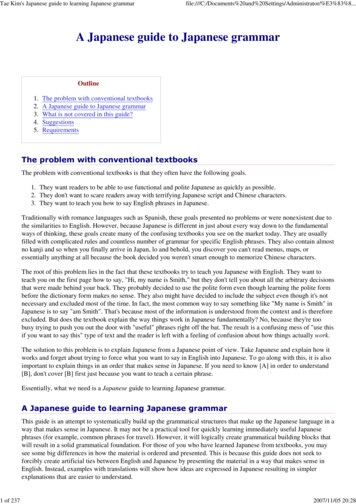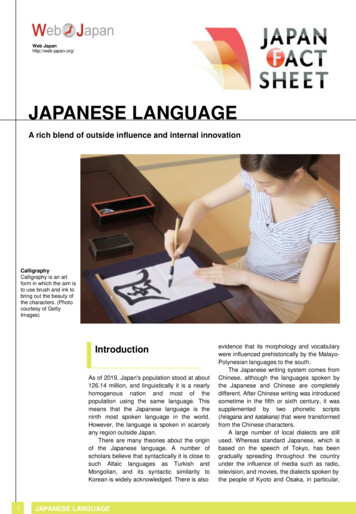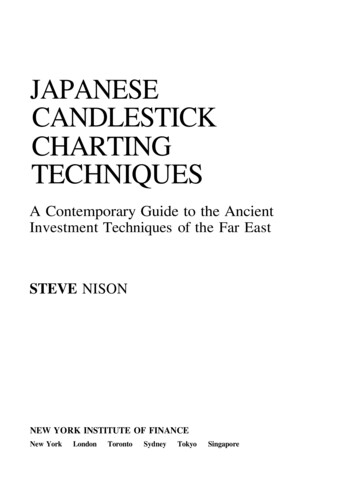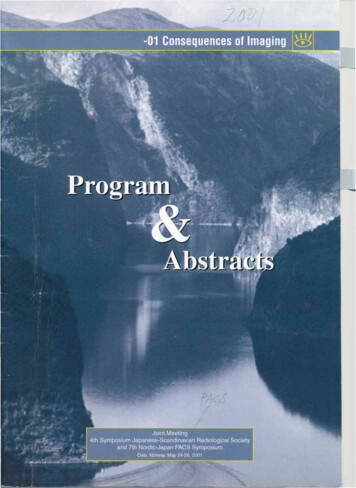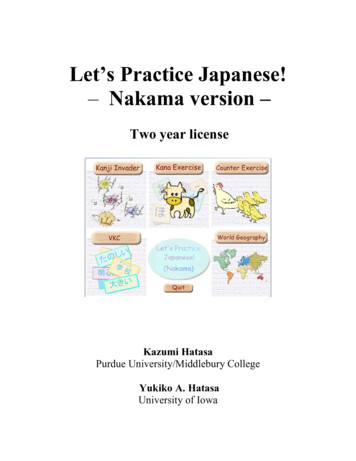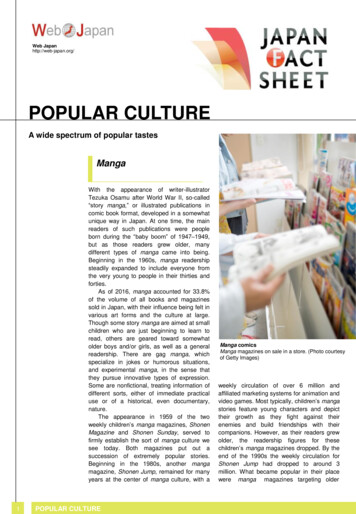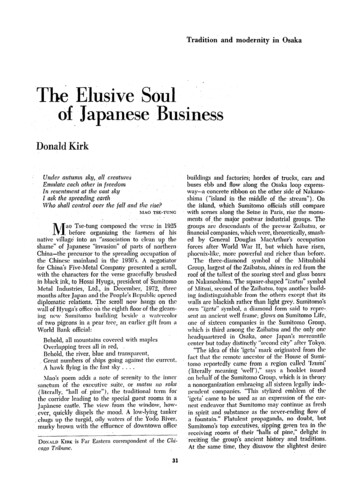
Transcription
Parissa HaghirianDr. Parissa Haghirian is the associate professor of international management atthe Faculty of Liberal Arts at Sophia University in Tokyo, Japan. She is also a visiting professor at Groupe HEC in Paris, Aalto University, Keio Business School, andan adjunct professor at Temple University in Tokyo. Parissa grew up in Austria,where she obtained her MA in Japanese Studies from Vienna University (1998). Shewas awarded MA (2000) and PhD in International Management (2003) by ViennaUniversity of Business, Austria. During her studies she had spent four years in EastAsia, mainly in Japan, and worked for several years in Japanese and European multinational corporations. After finishing her PhD, Parissa first became an assistantprofessor of international management in the Department of International Management at Kyushu Sangyo University in Fukuoka.Understanding Japanese Management PracticesToday, Japan is the most influential economy in Asia and the second largest economy in the world. Japanese consumers are among the richest in the world, and theJapanese market still provides profitable investment opportunities. Not only arethe Japanese able to adopt Western ideas and techniques without problems butthey also maintain a very unique perspective of the world.Japanese management practices are no exception. And this outstanding newbook, Understanding Japanese Management Practices, gives you and other international managers an in-depth look at Japanese management practices and how thesecan be implemented into Western corporations. It examines the cultural foundations of Japanese management and explains the most famous Japanese businessconcepts, such as kaizen (just-in-time) and lifetime employment. It then providespractical advice on how to successfully enter and position Western products in theJapanese market. Finally, it provides an advice on how to negotiate successfullywith Japanese business partners and reveals what Western managers can learnfrom Japanese management practices.Japanese management practices have had an enormous influence on Westernmanagement practices over the past few decades. Many Japanese managementpractices have become a standard in Western firms. This book will undoubtedlyguide you through Japanese business practices and how these practices help toimprove business processes and to increase quality and efficiency in numerouscorporations worldwide. It will also help you learn more about what Japanese management is and how do Japan’s management practices differ from those in theWest.HaghirianUnderstanding Japanese Management PracticesInternational Business CollectionS. Tamer Cavusgil Michael R. Czinkota Gary cesParissa HaghirianInternational Business CollectionS. Tamer Cavusgil Michael R. Czinkota Gary KnightEditorsISBN: 978-1-60649-118-890000www.businessexpertpress.com9 781606 491188www.businessexpertpress.com
Understanding JapaneseManagement Practices
Understanding JapaneseManagement PracticesParissa Haghirian
Understanding Japanese Management PracticesCopyright Business Expert Press, LLC, 2010.All rights reserved. No part of this publication may be reproduced,stored in a retrieval system, or transmitted in any form or by anymeans—electronic, mechanical, photocopy, recording, or any otherexcept for brief quotations, not to exceed 400 words, without the priorpermission of the publisher.First published in 2010 byBusiness Expert Press, LLC222 East 46th Street, New York, NY 10017www.businessexpertpress.comISBN-13: 978-1-60649-118-8 (paperback)ISBN-10: 1-60649-118-0 (paperback)ISBN-13: 978-1-60649-119-5 (e-book)ISBN-10: 1-60649-119-9 (e-book)DOI 10.4128/9781606491195A publication in the Business Expert Press International BusinesscollectionCollection ISSN: 1948-2752 (print)Collection ISSN: 1948-2760 (electronic)Cover design by Jonathan PennellInterior design by Scribe Inc.First edition: August 201010 9 8 7 6 5 4 3 2 1Printed in the United States of America.
AbstractToday, Japan is the most influential economy in Asia and the second largest economy in the world. Japanese consumers are among the richest inthe world, and the Japanese market still provides profitable investmentopportunities. Not only are the Japanese able to adopt Western ideas andtechniques without problems but they also maintain a very unique perspective of the world.Japanese management practices are no exception. And this outstanding new book, Understanding Japanese Management Practices, gives youand other international managers an in-depth look at Japanese management practices and how these can be implemented into Western corporations. It examines the cultural foundations of Japanese managementand explains the most famous Japanese business concepts, such as kaizen,just-in-time, and lifetime employment. It then provides practical adviceon how to successfully enter and position Western products in the Japanese market. Finally, it provides an advice on how to negotiate successfully with Japanese business partners and reveals what Western managerscan learn from Japanese management practices.Japanese management practices have had an enormous influence onWestern management practices over the past few decades. Many Japanese management practices have become a standard in Western firms.This book will undoubtedly guide you through Japanese business practices and how these practices help to improve business processes and toincrease quality and efficiency in numerous corporations worldwide. Itwill also help you learn more about what Japanese management is andhow do Japan’s management practices differ from those in the West.KeywordsJapan, Japanese management, Asia, international management and marketing, culture, cross-cultural management, market entry, negotiations
ContentsList of Tables. . . . . . . . . . . . . . . . . . . . . . . . . . . . . . . . . . . . . . . . . . . viiiPreface . . . . . . . . . . . . . . . . . . . . . . . . . . . . . . . . . . . . . . . . . . . . . . . . ixPart ICharacteristics of the JapaneseCorporation. . . . . . . . . . . . . . . . . . . . . . . . . . . . 1Chapter 1Kaizen and Total Quality Management. . . . . . . . . . . . . 3Chapter 2Human Resource Management. . . . . . . . . . . . . . . . . . 13Chapter 3Production Management. . . . . . . . . . . . . . . . . . . . . . . 31Chapter 4Knowledge Management. . . . . . . . . . . . . . . . . . . . . . . 39Part IIDoing Business With the Japanese . . . . . 53Chapter 5Entering the Japanese Market . . . . . . . . . . . . . . . . . . . 55Chapter 6Succeeding as a Foreign Manager in a Japanese Firm. . 75Chapter 7Intercultural Challenges When Working in Japan . . . . 91Chapter 8Selling Your Product to Japanese Customers . . . . . . . 107Chapter 9Negotiations With Japanese Business Partners. . . . . . 125Part IIIWhat Can Western ManagersLearn From Japan?. . . . . . . . . . . . . . . . . . . . . 137Chapter 10 Learning From Japanese Management. . . . . . . . . . . . 139Glossary . . . . . . . . . . . . . . . . . . . . . . . . . . . . . . . . . . . . . . . . . . . . . 145Notes. . . . . . . . . . . . . . . . . . . . . . . . . . . . . . . . . . . . . . . . . . . . . . . . 147References . . . . . . . . . . . . . . . . . . . . . . . . . . . . . . . . . . . . . . . . . . . . 151Index . . . . . . . . . . . . . . . . . . . . . . . . . . . . . . . . . . . . . . . . . . . . . . . 155
TablesTable 1.1Overview of the 5S System . . . . . . . . . . . . . . . . . . . . . . 8Table 4.1Knowledge Management in Japan and in the West . . . 41Table 4.2New Product Development in WesternCorporations and in Japanese Corporations. . . . . . . . . 48Table 4.3Changes Regarding Knowledge Management inContemporary Japanese Organizations . . . . . . . . . . . . 50Table 5.1Support Organizations for Entering theJapanese Market. . . . . . . . . . . . . . . . . . . . . . . . . . . . . . 63Table 5.2Challenges When Attempting to Enter theJapanese Market. . . . . . . . . . . . . . . . . . . . . . . . . . . . . . 64Table 5.3Challenges When Looking for a BusinessPartner in Japan. . . . . . . . . . . . . . . . . . . . . . . . . . . . . . 66Table 5.4Challenges When Establishing a Subsidiaryin Japan. . . . . . . . . . . . . . . . . . . . . . . . . . . . . . . . . . . . 67Table 5.5Overview of Challenges When Enteringthe Japanese Market. . . . . . . . . . . . . . . . . . . . . . . . . . . 71Table 6.1Differences Between Japanese and WesternProject Management. . . . . . . . . . . . . . . . . . . . . . . . . . 87Table 8.1Networking Organizations for ForeignEntrepreneurs and Managers in Tokyo. . . . . . . . . . . . 121Table 9.1Dos and Don’ts When Negotiating Withthe Japanese. . . . . . . . . . . . . . . . . . . . . . . . . . . . . . . . 135
PrefaceWhen I first went to Japan almost 20 years ago, I was a student of international business. To support my expensive language classes in Tokyo, Igot a job in a Tokyo firm, where I stayed for more than 2 years. This wasmy first job, and at that time, I had no comparison with what it would belike to work in a Western firm.I loved working in a Japanese firm. People were very friendly and supportive, the enthusiasm of employees for their job and their companywas enormously high, and there was real team spirit. Even after returning to my home country, I continued to work in a Japanese corporationin Vienna, where I worked at one of Japan’s major broadcasting corporations. Work was very demanding, but again, the Japanese team washighly motivated, the atmosphere was family-like, and all employees weretreated with great respect.It was only at the age of 27 that I first entered a Western firm. This wasthe biggest culture shock I have encountered so far. After being socializedinto a Japanese firm for more than 7 years, the Western firm seemed anaggressive and very uncooperative place. I still remember how shocked Iwas to see great competitiveness between employees—something I hadnever experienced before. Communication styles were very different aswell: In Western firms, employees seemed to be very careful about whatthey said to each other, whereas in Japan, we had no real secrets withinthe firm. It took me a few months to recognize the benefits of a Westernworkplace in which praise is more individually awarded and I was seenmore as an individual than as a team member.I enjoyed working in both systems. But I was always, and still am,amazed how complementary and at the same time how successful bothare. Western business practices focus on individuals and gain competitiveadvantages by using their different views, opinions, and ideas as a largerpool from which to extract ideas that benefit the firm. Japanese organizations stress group orientation and build their competitive advantages onmerging each group member’s views and attitudes into a larger, new idea.
xPrefaceWestern organizations have a stronger focus on differentiating themselvesfrom other firms, whereas Japanese firms do not mind reviving ideas thathave been successful in another part of the world.Both the Western and the Japanese management systems have theirstrengths and weaknesses, but they both represent very unique ways oflooking at the world and at business. No wonder that managers in theEast and West develop very different solutions to similar problems. Japanese business practices are not applicable in all Western business challenges, but they often provide solutions that are very different from thosefound in Western firms. But the differences between management in theEast and West often lead to confusion and misunderstandings on bothsides. In my classes, students often ask which management style is better, and my answer is always the same: There is no perfect managementsystem. Both the Western and Japanese systems have their flaws and theirstrong points. Depending on the economic situation, they either lead tosuccess or can lead to failure.When I set out to become a researcher an international management,my main goal was to investigate and communicate various ways of managing a firm successfully. Understanding Japanese Management Practicespresents the results of my experience in Japanese firms and my researchon the topic. Today, after working most of my professional career inJapanese organizations, I still consider Japanese management practicesas very unique and complimentary to Western management practices.These practices can provide a lot of inspiration to managers and researchers outside of Japan and support the development of new solutions toglobal management challenges. International managers should thereforebe familiar with both systems in order to develop a strong and diversemanagement skill set.Understanding Japanese Management Practices describes Japan as aplace for business and discusses the management practices that madeJapan famous throughout the business world. It explains the social concepts on which Japanese management is based and its most famous business practices. The book covers the major management practices knownin the West and also presents Japanese techniques and facts that so farhave not been discussed in Western media or research. It describes worklife in the Japanese firm and shows what non-Japanese managers need to
Prefacexiknow when doing business with the Japanese. Negotiations with the Japanese and entry into the Japanese market are both discussed, and Japanesebusiness etiquette is explained. The book closes with a chapter on whatWestern managers can learn from Japanese management practices.Understanding Japanese Management Practices targets managers, students of business, and students of Japanese anthropology who are interested in modern Japanese management and how Japan’s managementpractices can be used to increase competitive advantage.Parissa HaghirianSophia UniversityTokyo, JapanApril 2010
Part ICharacteristics of theJapanese Corporation page
nese management practices have become a standard in Western firms. This book will undoubtedly guide you through Japanese business prac- tices and how these practices help to improve business processes and to increase quality and efficiency in numerous corporations worldwide. It will also help you learn more about what Japanese management is and how do Japan’s management practices differ from .
